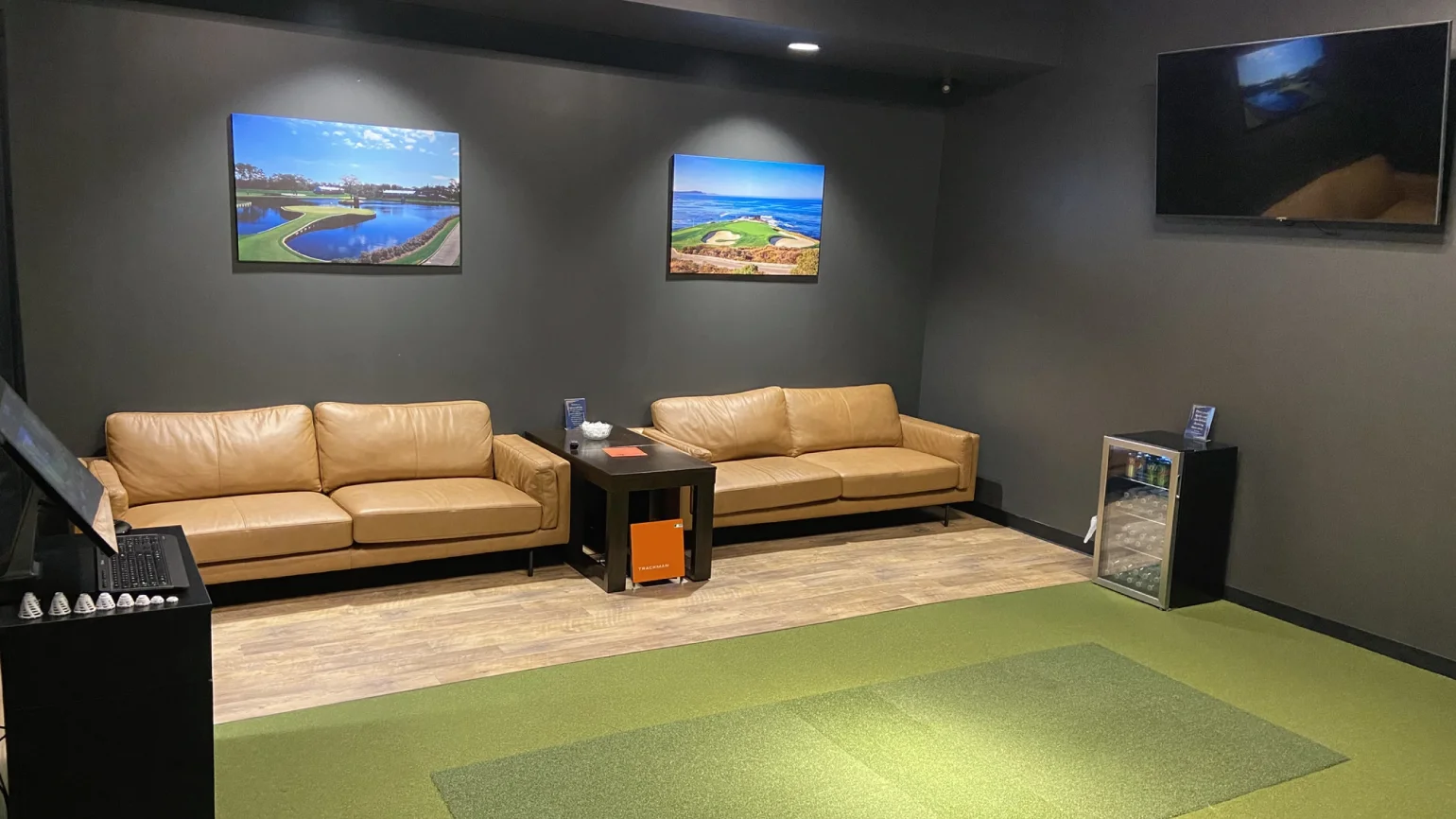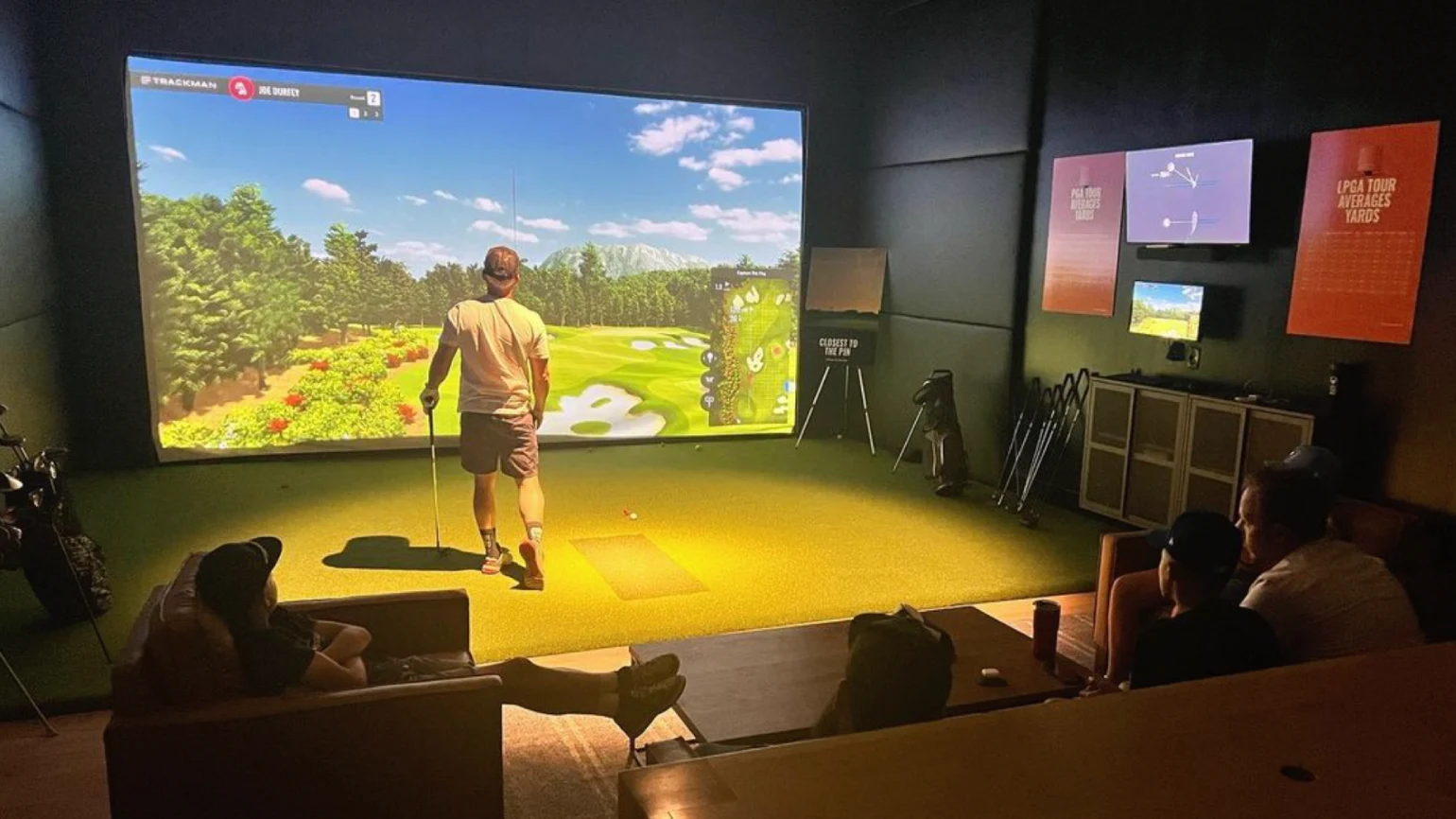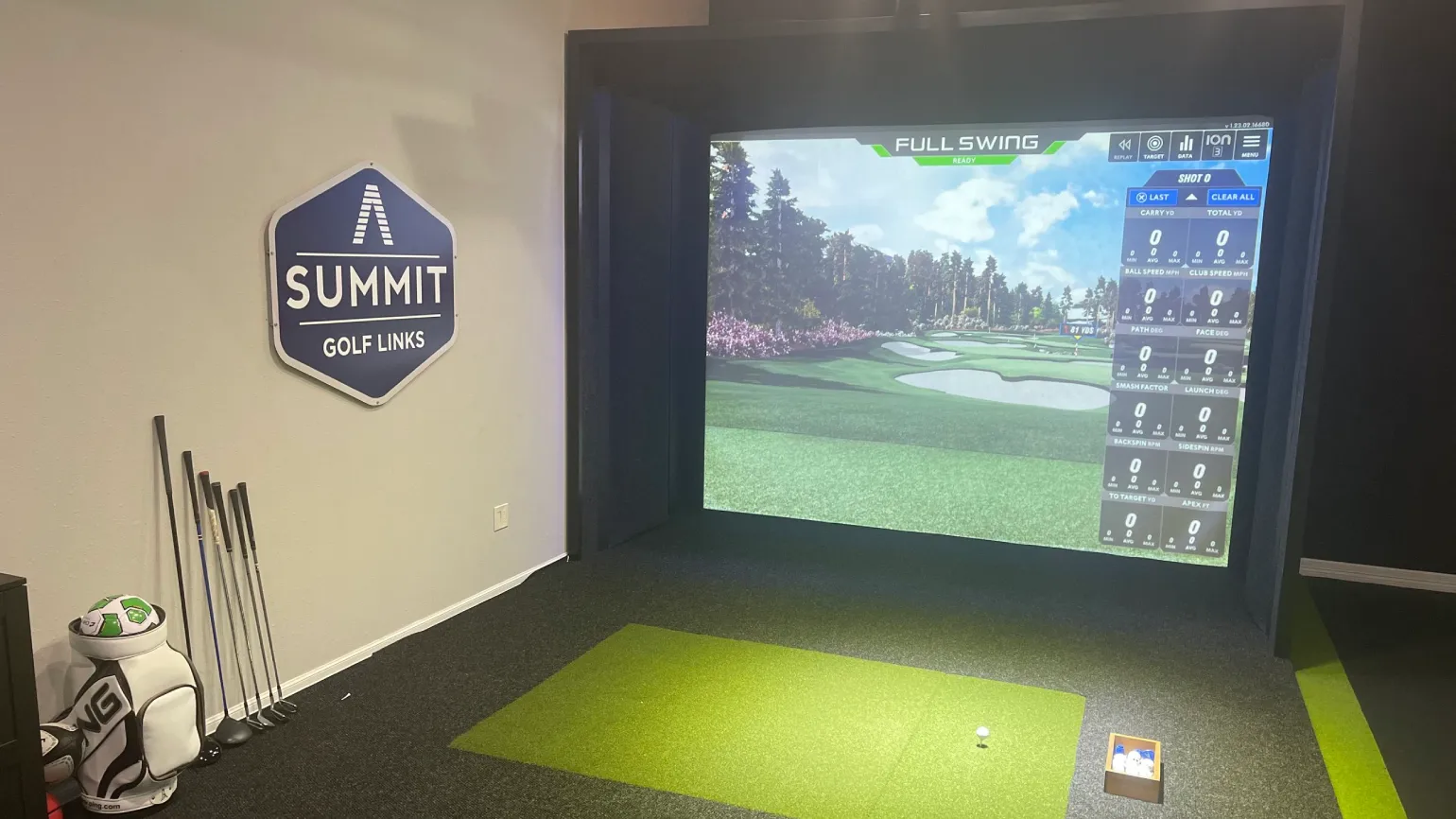
Gone are the days of 6-month golf seasons and traveling to find the perfect golfing weather.
Golf simulator businesses and indoor golf facilities are popping up all over the world to help enthusiasts advance their skills and enjoy the sport year-round.
At the surface level, the golf simulator business model seems simple. But what exactly is involved in creating a successful and profitable golf simulator business?
Here at Optix, we’ve helped a number of golf simulator businesses open their doors in the last two years, and we’re bringing you all of the insights and lessons we’ve learned along the way.
Learn all about what a golf simulator business is, how to ensure profitability and repeat business, and the steps you’ll need to take to make your golf simulator business stand out in this rapidly growing industry.
What is a golf simulator business?
A golf simulator business is an indoor space outfitted with several bays that simulate a golfing experience using sophisticated golf simulator software.
According to Golfstead, this computerized setup mimics a real game of golf, complete with life-like golf course renditioning and unique data and insights to help you analyze your swing and improve your overall performance.
Golf simulator businesses make the virtual golf experience more accessible for amateur and professional golfers alike by providing high-tech golf simulators that can be rented on demand.
Each simulator is situated in its own room and can be booked individually. Customers can bring their own clubs or rent high-quality equipment on-site.
Commercial golf simulator businesses will oftentimes come with food and beverages to purchase as well as other amenities like locker rooms, retail golf equipment, and private coaching sessions.
Why are golf simulator businesses so popular?

If it feels like there are more indoor golf facilities today than there were five years ago, you’re not wrong.
Modern golf businesses have exploded in recent years, with the golf simulator market expected to grow by 9.2% over the coming years. So why are golf simulators taking over?
Golf had a resurgence during the COVID-19 pandemic
Golf became the game of choice during the pandemic due to its ability to be played safely outdoors. In 2020, there were 24.8 million golfers in the US, a 2% increase from 2019 and the largest net increase in nearly 20 years.
More than three years later, the game continues its meteoric rise in popularity.
Advancements in technology are making golf simulators more powerful
The first golf simulator was invented in the 1970s. Since then, the technology has advanced considerably with the modern simulator looking far different than those before. Now, a golf simulator provides you with:
- Accurate renditions of world-famous golf courses from around the world
- Lifelike golf course conditions, complete with foliage and course curvature
- An analysis of your game and how to improve it
The technology is now so advanced that you can easily spend a few hours on a golf simulator in lieu of an outdoor golf course without missing out on any of the experience.
Virtual golf makes golfing year-round possible
As every golfer knows, the season is limited – especially for those living in northern environments. Golf simulator businesses bring an exceptional golfing experience to those living in colder climates and makes year-round golfing possible.
Golfing creates an opportunity for social interaction
While some golf simulators operate like a gym, others operate like a country club. This creates opportunities for social interaction and networking with other golfers and golf enthusiasts that is appealing to the modern golfer.
Coworking + Golf: What is the relationship?
In our coworking niche series, we break down all of the ways that different industries are borrowing from the coworking model.
Golf simulators are no exception.
At the surface level, a coworking space and a golf simulator may seem unrelated. However, there are many similarities between the two. Both coworking spaces and golf simulator businesses:
- Primarily make money by selling space or community
- Offer bookable resources on-demand
- Operate a membership-based business
- Offer additional amenities to attract and retain customers
- Can manage their space with automation software like Optix
Let’s take a closer look at the indoor golf business model and how it resembles coworking.
The golf simulator business model

Similar to the coworking space business model, golf simulators make money by selling space in the form of access to golf simulators.
Typically, entrepreneurs will lease or buy a commercial space. They will then create one or several separate golfing areas in the space and outfit them with golf simulator software.
They then rent these spaces on-demand and/or offer recurring memberships. Apart from selling space, golf simulator businesses also drive revenue by offering:
- Food and beverages to purchase
- Equipment to rent (ie. golf clubs or balls)
- Private lessons with on-site instructors
- Products to purchase (ie. gloves, merchandise)
- After-hour event rentals
- Club fitting and custom club sales
Together, these revenue streams cover the cost of running the facility including rent, electricity, staff, and more.
Are golf simulator businesses profitable?
Profitability is a hot topic in the coworking world, as in the indoor golf world. Golf simulator businesses can be very profitable. However starting a golf simulator business requires a high upfront cost.
Consider this –
In order to properly outfit an indoor facility for a golf simulator business, you’ll need a number of golf simulators. These golf simulators consist of hardware and software.
- The hardware is the physical equipment (projector, enclosure, sensor, etc.) that will be in the space. It often includes the one-time cost of installation.
- The software is the program that run on the hardware (ie. games, golf courses) and are typically charged monthly.
The cost of golf simulators varies widely depending on the quality of the technology. One popular golf simulator on the market for commercial spaces is the Uneekor Eye XO. The Simkit, which comes complete with everything you would need for one bay, costs between $17,000 and $19,000 depending on the customization options. This includes the one-time software cost of $1,000.
More advanced simulators can easily cost up to $60,000 a piece. If you want your business to have three or four simulators, you’re looking at an upfront investment of anywhere between $75,000 and $240,000 on equipment alone.
Considering the cost of renting and building out a space, starting a golf simulator business can be well over $350,000.
One strategy that some successful facilities use to keep costs low is outfitting their space with a few different golf simulators and pricing them accordingly. For example, you could offer one or two budget-friendly simulators available at $25/hr and one or two high-end simulators at $50/hr.
The good news is, there is relatively little overhead with a golf simulator business and the margins can be very high. Once the equipment is purchased, you can open a space and begin making that money back immediately.
Attendance and revenue fluctuations
One important piece to keep in mind when it comes to the profitability of a golf simulator is attendance fluctuations. Attendance in this industry can be highly dependent on time of day and weather. Indoor golf facilities tend to be slower during the summer and when the weather is nice, which can impact revenue predictability.
Weekday mornings and afternoons also tend to be slower times, as golf simulators typically attract weekend and afternoon crowds. Consider these factors when building out realistic financial projections and keep in mind a marketing strategy you can use to bring more people in during the off-season (such as discounts during the summer).
What do you need for a golf simulator business?
The most important part of a golf simulator business is the technology itself.
Having a high-quality simulated golf experience that resembles a traditional golf course is absolutely necessary to attract people to your space. These costs are non-negotiable and are an integral part of attracting avid golfers and a loyal customer base.
Golf simulator technology can be purchased in a bundle which includes the launch monitor, custom enclosure, hitting mat, landing turf, and projector. You could also purchase all of these pieces separately depending on what your needs are.
For example, you may choose to have a custom enclosure, or you may choose to have an open set-up resembling a driving range.
Apart from the equipment itself, here are some other common needs for a golf simulator business:
- On-site equipment to rent including golf clubs of various sizes and golf balls
- Food and beverage offerings (be sure to look at and obtain all of the necessary licenses if you do choose to offer food and beverages on-site).
- Staff to run the facility like a community manager
Examples of golf simulator businesses
Here at Optix, our technology supports a variety of business models, from coworking spaces to golf simulators. Here are four examples of golf simulator businesses (and Optix clients!) that are bringing fantastic indoor golf facilities to their communities.
Lighten Golf Club

Lighten Golf Club is a luxury indoor golf facility located in Riverton, Utah. They offer beautifully designed spaces, refreshments, private lessons, and so much more.
They’ve created an exceptional golf simulator experience, complete with high-end technology and an outstanding customer experience. They also offer a wide variety of membership options at an affordable price to meet the needs of their members.
Scratch Golf Lab

Scratch Golf Lab is a 24/7 golf simulator experience with five locations in the US. They’re committed to supporting those at all levels of golfing experience, from beginners looking to build fundamentals to professionals looking for an enhanced golfing experience.
At Scratch Golf Lab, their simulators are equipped with Trackman 4 technology to provide an elite golfing experience to their members and give them data-driven insights to improve performance.
Shots Factory

Shots Factory is an indoor golf practice facility located in Hong Kong. Their impeccably designed 24/7 facility makes golf accessible to a wide variety of members at any time of the day, complete with simple and affordable pricing plans.
At Shots Factory, members can access the unparalleled advantages of TrackMan technology, private lessons from a PGA golfer, elite level golf equipment, and so much more, making it the ultimate hub for golfers in Hong Kong.
“Shots Factory is an indoor golf practice facility for beginners and experienced players alike. We offer golfers in Hong Kong an unparalleled level of access and convenience to golf, with simple and affordable pricing plans, and 24/7 access.”Shots Factory, Website
Summit Golf School

Summit Golf School is a golf school offering golf lessons, club fitting, and a Full Swing Simulator experience. Their golf simulator includes over 20 championship golf courses, target practice, range practice, and multiple sports beyond just golf.
Members can book the simulator room using Optix and utilize remote door access to access the space, making it an easy and convenient way for members to access a high quality golf experience at a fraction of the cost.
“The process of playing the best golf of your life is our passion. We are committed to helping you develop your golf game at every level.”Summit Golf School, Website
If you’re a golf enthusiast with an entrepreneurial itch to scratch, then starting a golf simulator business may be just what you need.
Here is a step-by-step guide to getting started with opening an indoor golf facility, along with some tips to keep in mind at each step.
Step 1: Define your audience and goals
Every good business starts with who you’re serving and why. This is particularly important for those looking to start a golf simulator business because the offering can vary dramatically depending on your audience.
Here’s what we mean.
- Family-friendly indoor golf facilities: if your target audience is families, you may want to focus more on the experience and the software offering (ie. games for kids), rather than having the most expensive piece of hardware equipment.
- Amateur entertainment indoor golf experience: a golf simulator for entertainment purposes, like a fun night-out with friends, may have less of a focus on technology and hardware, and more of a focus on food and experience. Here, you may want to have a full-service kitchen and bar.
- Professional-level golf simulator: an indoor golf facility targeting professional golfers and aspiring professionals will be highly focused on the level of cutting-edge technology you offer and the services, like one-on-one coaching with former golf pros.
Determining who you’re serving will help dictate all future decisions you make for your business. It’s never a bad idea to create a business plan that helps you summarize your findings.
Step 2: Determine your business model
Business models change frequently, but you’ll need an understanding of the finances of your business before moving forward with any plans.
One of the major reasons why indoor golf simulators often fail is because they don’t properly manage their start-up costs. It’s a common issue, considering the high upfront cost of starting an indoor golf facility as previously discussed.
Map out your business model from the beginning to ensure financial viability. Here’s what that could look like.
- Cost of building rent: $8,000/mo
- Cost of equipment: $80,000
- Cost of buildout: $20,000
- Additional operating costs: $2,000/mo
Let’s say your monthly operating expenses are $10,000 and your upfront investment cost is $100,000 for a small business with two simulators.
You’ll need to price your memberships in a way that generates $18,000/mo to get paid back in full and break even in one year of operation. This assumes no other unforeseen costs, which can be tricky for operators.
Step 3: Secure a location
Much like a coworking space, securing a location is an extremely important part of starting a golf simulator business. You’ll want to choose some place where your target market is, where golf is popular, and where people may not be able to golf year-round.
The northern part of the United States and Canada, as well as other areas with extreme climates, tend to be most popular for golf simulator businesses because the golfing season there is limited by weather conditions.
Another important element to consider at this step is how big of a space you will need. Because it can be difficult to determine demand in the beginning, many operators choose a space that they can expand into as needed.
You’ll need a big enough space to generate enough revenue to cover your operating costs, but too much space means higher rent and the potential for bays to be sitting empty.
Step 4: Purchase all of the necessary equipment
Once the space is secured and the buildout is complete, you’ll need to purchase the equipment for the space. As discussed earlier, this is the biggest and most important expense.
NOTE: Some operators have a sense of what equipment they want before they find the space, to ensure that the space they choose will be able to support their technology choices.
There are lots of resources available to help you find the best golf simulator for your business. Here are some tips to keep in mind when considering your options.
- Budget: based on your financial projections, you should have a target budget in mind for the equipment you’ll be purchasing. This will dictate whether your purchase will be in the low, mid, or high range of offerings (or whether you’ll have a mix of all three).
- Size of space: the size of space is incredibly important. Golf simulator projectors are offered at a number of ratios, the most popular being 16:10 and 4:3. The size of the space you have available to you will determine the ratio of the projector you purchase.
- Quality: choosing the right golf simulator for your business is heavily influenced by the quality of the sim you’re offering, and is an important factor to consider.
Step 5: Set up your operations

After the physical space is in order, you can turn your attention to the operations.
Operating a successful golf simulator business involves welcoming people into the space, processing invoices and payments, managing bookings of the simulator bays themselves, giving access to the space, and more.
Managing all of these tasks manually can quickly eat up valuable time and resources of your staff, especially as your member base grows. To avoid disruptions and ensure efficiency, consider using a space automation software like Optix to run your business.
A number of our flex space clients use Optix to run their indoor golf business and automate their most manual, time-consuming tasks. With Optix, you can:
- Automate all bay bookings
- Automate and process all membership payments
- Make data-driven decisions with detailed space analytics
Jesse McLean, Founder at Scratch Golf Labs, uses Optix to automate several aspects of his business, including automating communication every time someone makes a drop-in booking. As a small team, it’s saved him a lot of time while making it easier to connect with his members.
Learn more about how Optix can help you automate your business.
Step 6: Figure out your pricing
Depending on the business model, we most commonly see memberships offered as tiers in a golf simulator business. Examples of a membership could be:
- $250 a month for unlimited bookings with a 12-month commitment
- $500 a month for unlimited bookings for corporate teams
- $400 for a ten-time punch pass
- $50/hr for on-demand hourly bookings
As with coworking, memberships are the best way to generate reliable, predictable revenue. However, if you are located in a region or you have a demographic where you can rely fully on drop-in and hourly bookings, it will be much more profitable for your golf simulator business.
Step 7: Market your golf simulator
In coworking, we often say the best time to build community is before you ever open your doors. The same can be said for marketing your golf simulator.
The best time to begin building a presence in the community is before your business is open.
- If you are a passionate golfer, you can create connections with the local golf community and potential customers in your area to seed interest in your idea.
- If you’re looking to appeal to the corporate crowd, consider attending local networking events to gauge interest in corporate events at an indoor golf facility.
Social media promotion can also begin for potential new customers long before you open your doors. Everyone loves watching a business being built from the ground up. Consider starting an Instagram account or YouTube channel to document your journey of building your business.
This will help educate others about how to start a golf simulator business while bringing more visibility to your venture.
Some other marketing strategies could be:
- Setting up a Google Business Profile to capitalize on local traffic searching for “indoor golf near me”
- Consider running Google ads to high-intent keywords like “golf simulator near me”
- Run discounts and promotions for your first month of opening and offer grandfather pricing to members who sign up for an annual membership to get quick revenue
- Reach out to local publications for free PR – local magazines and news publications love covering new facilities opening in the area
If you’re looking for inspiration on how to be successful in starting your business, Starter Story profiled seven case studies of golf simulator businesses that achieved success (upwards of $500,000/mo in revenue!).
Get started with your golf simulator business
As a rapidly growing sector of the fitness industry, there is a world of opportunity in creating a golf simulator, especially for those in cooler climates unsuitable to outdoor golf.
As you get started on your golfing journey, you may want to consider Optix to help you automate key operations, save time, and improve operational efficiency. By taking care of the redundant, manual tasks, Optix can help make your journey to starting a golf simulator or indoor golf facility a smoother experience.
Want to learn more about how we’ve supported other golf simulators to expand their operations and streamline their day-to-day management of the space? Connect with a member of our team today.






![A Complete Guide to the Coworking Sales Funnel [2024]](https://www.optixapp.com/wp-content/uploads/2024/04/A-Complete-Guide-to-the-Coworking-Sales-Funnel-2024.webp)